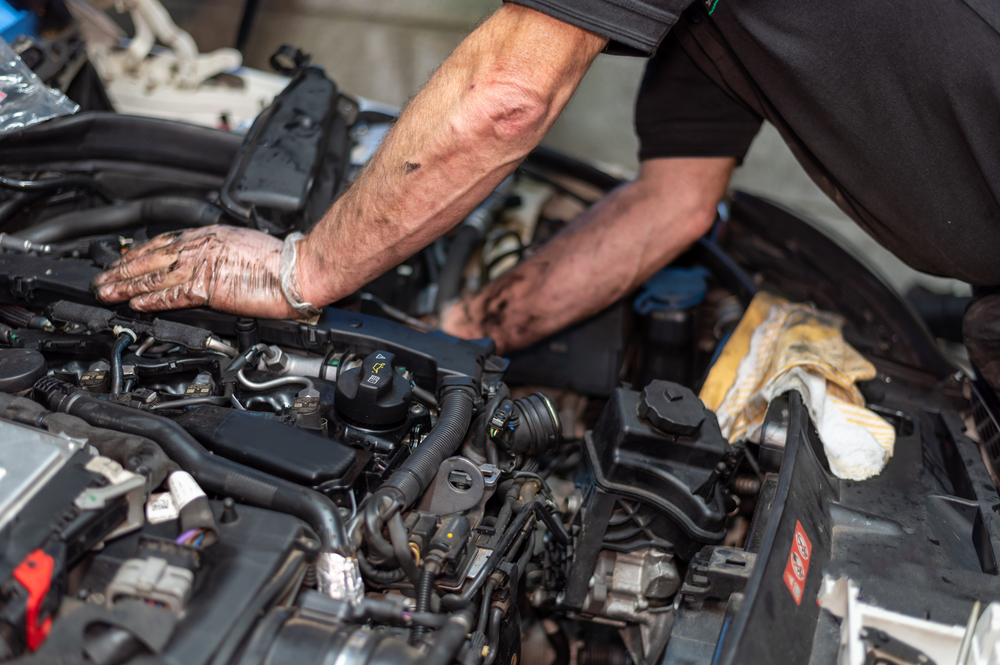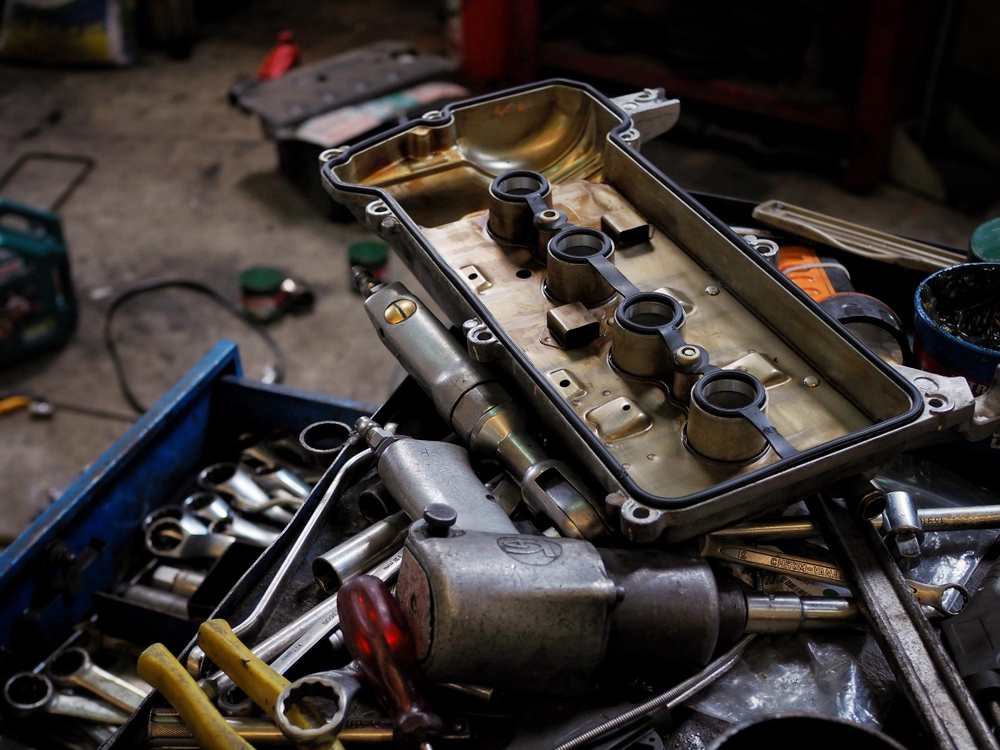If you don’t know much about cars, every visit to your mechanic can be terrifying. You never know when they’re going to tell you that some part you’ve never heard of has gone out — and that it will cost a small fortune to fix it.
Take your valve cover gasket, for example. What is it? What does it mean if it breaks? Are you going to have to sell a kidney to be able to afford to replace it?
We’ll have the answers to all these questions and more below, so there’s no reason for you to panic — and for Pete’s sake, stop trying to get your mechanic to agree that your left kidney feels especially succulent today.
- What Does the Valve Cover Gasket Do?
- What Causes a Valve Cover Gasket Leak?
- How to Tell if You Have a Leaky Valve Cover Gasket
- What Will It Cost to Repair a Leaky Valve Cover Gasket?
- How to Fix the Problem Yourself
- Can You Drive With a Leak in Your Valve Cover Gasket?
- Can I Just Use a Leak-Sealing Product Instead of Doing All This Work?
- Final Thoughts
What Does the Valve Cover Gasket Do?
Before we can tell you what a valve cover gasket does, we need to remind you of a few key facts about your engine
Engines get hot, and if they get too hot, things can break. That’s why you need to use motor oil, as it lubricates all the moving parts and reduces friction, so there’s less risk of damage.
However, if your engine isn’t sealed, that motor oil will go flying everywhere and leak out onto the ground. What’s more, dirt and debris would be able to get into the engine, causing even more damage.
Your valve cover gasket is what seals the engine and keeps all that gunk out. It also seals the spark plugs, keeping them in prime working condition.
While that all sounds good and reassuring, damaged valve cover gaskets are also the most likely cause of an oil leak in your engine.
What Causes a Valve Cover Gasket Leak?
Most valve cover gaskets are made of silicon rubber or cork, and while they’re great at sealing off your engine, they’re also fairly delicate. They’re especially prone to damage on their sides, which is where they’re most likely to crack.
Catastrophic failures are possible, but they’re rare. It’s much more likely for a leak in the valve cover gasket to develop slowly. It will crack in one place and you’ll notice a slight leak, and if you ignore it, the crack (and the leak) will worsen over time.
Those cracks can happen for a variety of reasons. The gasket could warp due to constant exposure to high temperatures, the vibration of the engine could break it, or high pressure could cause it to snap.
How to Tell if You Have a Leaky Valve Cover Gasket
If your valve cover gasket has sprung a leak, the first thing you’ll likely notice is, well, a leak. Since one of its primary purposes is to seal oil inside the engine, a leaky gasket will allow that oil to spill out.
As mentioned previously, valve cover gasket leaks usually start off small and grow from there. Don’t expect to see a massive pool of oil under your car; rather, you’ll most likely see a small spot that grows over time.
An oil leak is usually the first sign that you have a leaky valve cover gasket, but if you leave the problem alone, there are other symptoms you’ll begin to notice.
Low Oil Levels
It’s simple physics: if you ignore an oil leak long enough, sooner or later you’ll run low on oil.
If your car’s engine oil light keeps coming on, that means there’s a leak somewhere — and the valve cover gasket should be the first place you look.
The Valve Cover Is Dirty and Coated in Oil
This one might seem obvious, but sometimes the obvious answers are obvious for a reason. Take a look at the valve cover and see if it’s caked in oil, dirt, and other grime.
If it is, the most likely explanation is an oil leak beneath the cover.
Burning Oil Smell
All that leaking oil has to go somewhere, and much of it will drip onto the cylinder head, exhaust pipe, or fuel intake. Those parts are all very, very hot — and the oil that drops onto them will quickly go up in smoke.
If you start smelling burning oil, that’s probably because there’s oil burning somewhere in your engine. You should figure out where it’s coming from (and it’s probably coming from your leaky valve cover gasket).
Engine Is Misfiring
While most of the leaking oil will drip onto the cylinder head or fuel intake, some of it may make its way into the spark plug tubes. If it gets in there, it can foul up the spark plugs, causing them to fire unreliably.
As a result, your car might start running rough and misfiring when you accelerate.
This particular issue could resolve itself, though, as the spark plugs could cause the oil to catch on fire. Problem solved! (You don’t actually want this to happen.)
What Will It Cost to Repair a Leaky Valve Cover Gasket?
The price of the repairs will depend on a variety of factors, including the type of gasket used and the make and model of the car.
Generally speaking, though, you can expect to pay between $10 and $50 for a new gasket. Labor costs could run between $100 and $300, depending on your mechanic and your car.
In some cars, the gasket cover is difficult to reach, as the mechanic will need to remove the turbo plumbing and intake components. That takes more time, and as greedy villains in movies have reminded us for years, time is money.
While repairing a leaky valve cover gasket isn’t terribly pricey, don’t let that fool you into thinking it isn’t important. Again, you’ll eventually run out of oil — and when that happens, many expensive components inside your engine could decide to kick the bucket.
If you have an older car, it’s possible that multiple parts could fail at once, so your leaks could be caused by more than just a leaky valve cover gasket. You should ask your mechanic to do a thorough leak inspection to make sure; as an added bonus, repairing multiple leaks at once will likely be cheaper than doing it all piecemeal.
How to Fix the Problem Yourself

If you don’t want to shell out a few hundred bucks to have a mechanic replace the faulty gasket for you, you can always try to do it yourself. New gaskets are fairly cheap, so it’s only a question of how much time you’re willing to invest in making the repairs.
It’s not the hardest job in the world, but your valve cover gasket is a critical component, so it’s not something you can safely screw up. If you don’t know what you’re doing, it’s better to let a pro handle it for you.
Still want to tackle the job yourself? Sounds good to us (hey, it’s not our car). Before you get started, though, you’ll need to gather the necessary tools:
- Plastic putty knife
- Rubber mallet
- Socket and ratchet set
- Brake cleaner
- Valve cover gasket kit
- Vulcanizing sealant
1. Remove the Decorative Valve Gasket Cover
Yes, you need to remove the valve cover gasket cover — it’s basically like a ridiculous Russian doll situation, except with a lot more motor oil and cursing involved.
Not every vehicle has a cover over their valve cover gasket, but it is fairly common. Most covers are bolted on, so grab your ratchet set and get to work.
You’ll likely see a variety of hoses, cables, and wires attached to the valve cover. They’ll need to be removed before you proceed, as well.
However, they’ll also need to be reattached later, so label them when you take them off to make sure nothing gets replaced incorrectly. You may also want to snap a quick picture of the layout before you move on.
After all the bolts and cables are removed, you might need to break the cover free using the mallet, especially if there’s a lot of caked-on oil and gunk around it. Tap softly, and don’t use any metal tools to pry it off, because there are a lot of aluminum cylinder heads that could easily be damaged accidentally if you do.
Once the cover comes off, set it aside and move on to Step 2.
2. Remove the Valve Cover Gasket
Ok, now that you’ve removed the decorative valve gasket cover, it’s time to remove the actual valve cover gasket. Clear? We’re going to assume you said yes, because we’re moving on.
Before you remove the actual gasket, you’ll want to take a rag and wipe up any oil that has coated the engine block. Be forewarned, though: if the leak has been going for some time, there will be quite a bit of oil to clean up.
The gasket should peel off fairly easily, but if it’s stuck, give it a tap with the mallet. Pry it off and take a look at it to see if it’s broken; if you can’t see any damage, the leak might be coming from somewhere else.
There might be traces of old sealant on the block, so scrape it off with the plastic putty knife. Again, never use metal tools to scrape or whack anything on the block. Also, be sure to prevent the old sealant from falling into the engine.
While you’re doing all this, pay attention to where the old sealant had been applied. Snapping another quick picture will go a long way towards making your life easier.
3. Replace the Valve Cover Gasket
Spray some brake cleaner on a rag and wipe down the surface where the cover will go. You don’t want any dirt or grime there, or else the gasket won’t seal properly, creating another leak for you to deal with.
Once you’re done cleaning, you’ll want to wait for everything to dry, so take a little break for a few minutes.
When you’re confident things are dry enough for you to proceed, apply some vulcanizing sealant in the same locations it had been applied before (you might want to consult that picture we told you to take). Don’t apply sealant to the valve cover gasket itself, though.
Put the valve cover gasket in place and make sure it’s firmly sealed.
Now it’s simply a matter of replacing the wires, hoses, bolts, and the cover that you took off in the first step. We really hope you took a picture of where everything went, because we certainly weren’t paying attention.
4. Check for Leaks
We know you did everything right and followed our instructions to the letter, but sometimes things go wrong, all the same. If that’s the case, it’s better to find out now than when you’re flying down the freeway.
Start the car and let the engine run for a few minutes. Check underneath the vehicle to see if there’s any oil dripping down.
If you don’t see a leak, congratulations — you’re done. If there is fluid dripping down, though, you’ll need to take everything apart again to find the problem. The problem is most likely a poor seal, but you’ll have to look to find out for sure.
Can You Drive With a Leak in Your Valve Cover Gasket?
It’s a bad idea to drive your car with an oil leak, regardless of the cause. Again, oil tends to be somewhat important for the proper operation of a modern vehicle.
If the leak is minor, you can continue to drive your car, but we’ll tell your mechanic you drove it over our objections. Be sure to monitor the oil levels, though, and carry a quart with you in case you need to refill it.
Understand that, if your valve cover gasket is already damaged, it increases the odds that it will break all the way at some point. If that happens, you could lose a lot of oil in a hurry — and that could lead to serious (and expensive) engine damage.
If you plan on continuing to drive your car with a leaky valve cover gasket, keep an eye on the amount of oil leaking out. If the leak gets visibly worse, you’re likely running out of time, so make a beeline for your mechanic’s shop.
Still, you should take your car to the shop as soon as you notice any sort of oil leak. It’s a relatively cheap repair, but if you let it go too long, it could turn into something quite catastrophic.
Can I Just Use a Leak-Sealing Product Instead of Doing All This Work?
If you spend any time in auto parts stores, you might notice products that are purportedly designed to stop leaks in your engine.
These products are certainly tempting to use, as all you have to do is pour the bottle in the engine oil reservoir. The idea is that, when you start your engine, the sealant will run towards the source of the leak, where it will then repair it.
However, they’re most likely too good to be true. They usually only work if there’s a gap in the seal, as they cause the gasket to expand, filling in any openings. They won’t help if the gasket is cracked or broken.
Even if they do end up working for you, the effects will only be temporary. At best, they can buy you a little bit of time before you have to take your car into a mechanic to get the problem properly fixed.
The fact that they work in the short-term often causes people to just keep using them over and over rather than addressing the root of the problem. Over time, though, this can cause your seals to soften and deteriorate, which could ultimately cause your leaks to multiply.
Final Thoughts

Oil leaks can be a serious problem for any car, and the valve cover gasket is the first place you should look if you’ve noticed drips underneath your car.
Replacing them is fairly cheap and easy, regardless of whether you do it yourself or pay a professional, so there’s no reason to drag your feet in getting the repairs done.
Then again, if you keep a sufficient amount of oil in your vehicle, it drastically reduces your chances of witnessing a totally sweet car fire. Life’s all about trade-offs, we suppose.




